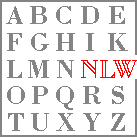



 | |
| The orthography of machine-readable Neolatin texts: A plaidoyer for minimal intervention | |
   |
The role of the editor (II)
Editors can do what they want, but shouldn't
Classical texts are 'normalized'. So why not do the same with Neolatin texts?
For most texts from antiquity the original orthography is lost, because they are only transmitted by medieval witnesses. If we could, we would surely try to respect Cicero's orthography. The same ought to be the case with the orthography of modern Latinity which, in contrast to that of Cicero, is amply documented.
Most texts on the net today are based on one witness, whose orthography therefore can be followed. 'Poor' spelling may reflect an author's lack of competence, and is thus part of the text. On the other hand, the editor needs to identify misprints that do not reflect the author's/writer's intentions (e.g. CONTZEN pol p.934b Atchistratergo for Archistratego).
Before Gutenberg, - less so later -, texts often are transmitted in several witnesses with equal authority. Even in texts with a more rich textual transmission an orthography akin to the author's can be established (ex.: Lorenzo Valla's letters ed. Regoliosi, Salutati's correspondence ed. Novati).